Collagen-calcium chelate and preparation method thereof
A technology of collagen and calcium chelate, applied in food preparation, food science, application, etc., can solve the problems of low absorption and utilization rate, inability to supplement collagen and calcium together, etc.
- Summary
- Abstract
- Description
- Claims
- Application Information
AI Technical Summary
Problems solved by technology
Method used
Image
Examples
Embodiment 1
[0022] Step 1: Weigh 100 mg of animal-derived collagen, dissolve it in 10 mL of double-distilled water, and then add calcium chloride solution with a volume concentration of 10 mg / mL and a volume of 1 mL to the animal-derived collagen solution, and the reaction temperature is 20 ° C. The reaction was carried out for 1.5 hours under stirring conditions, and at the same time, a sodium hydroxide solution with a molar concentration of 0.5 mol / L was added to control the pH value of the reaction solution to 4.0.
[0023] Step 2: After the above reaction is completed, the reaction solution is subjected to vacuum freeze-drying treatment to obtain collagen-calcium chelate.
Embodiment 2
[0025] Step 1: Weigh 100 mg of animal-derived collagen, dissolve it in 10 mL of double-distilled water, and then add calcium chloride solution with a volume concentration of 10 mg / mL and a volume of 1.5 mL to the animal-derived collagen solution, and the reaction temperature is 25 ° C. The reaction was carried out for 2 hours under stirring conditions, and at the same time, a sodium hydroxide solution with a molar concentration of 0.5 mol / L was added to control the pH value of the reaction solution to 4.0.
[0026] Step 2: After the above reaction is completed, the reaction solution is subjected to vacuum freeze-drying treatment to obtain collagen-calcium chelate.
Embodiment 3
[0028] Step 1: Weigh 100 mg of animal-derived collagen, dissolve it in 10 mL of double-distilled water, and then add calcium chloride solution with a volume concentration of 10 mg / mL and a volume of 1.5 mL to the animal-derived collagen solution, and the reaction temperature is 25 ° C. The reaction was carried out for 2.5 hours under stirring conditions, and at the same time, a sodium hydroxide solution with a molar concentration of 0.5 mol / L was added to control the pH value of the reaction solution to 4.0.
[0029] Step 2: After the above reaction is completed, the reaction solution is subjected to vacuum freeze-drying treatment to obtain collagen-calcium chelate.
PUM
 Login to View More
Login to View More Abstract
Description
Claims
Application Information
 Login to View More
Login to View More - R&D Engineer
- R&D Manager
- IP Professional
- Industry Leading Data Capabilities
- Powerful AI technology
- Patent DNA Extraction
Browse by: Latest US Patents, China's latest patents, Technical Efficacy Thesaurus, Application Domain, Technology Topic, Popular Technical Reports.
© 2024 PatSnap. All rights reserved.Legal|Privacy policy|Modern Slavery Act Transparency Statement|Sitemap|About US| Contact US: help@patsnap.com










